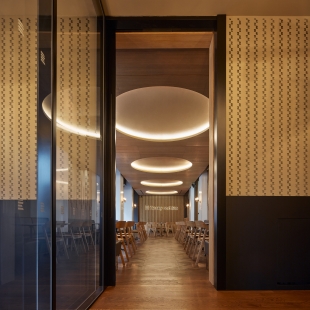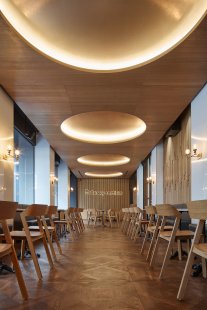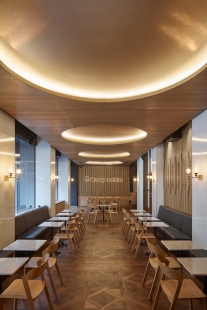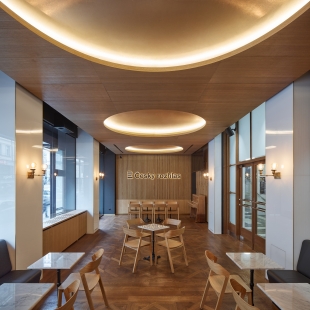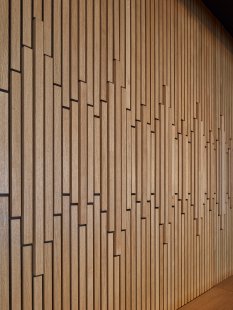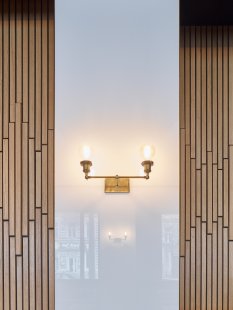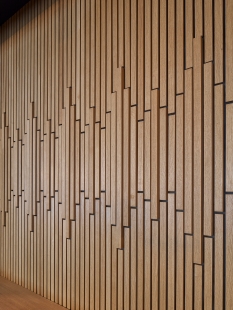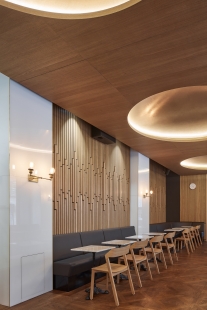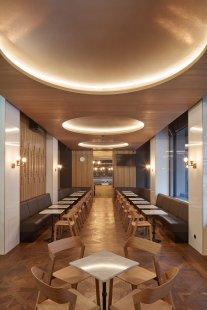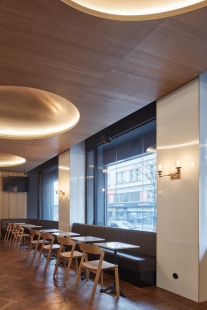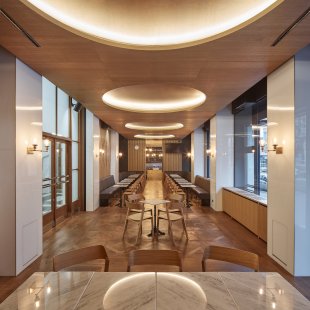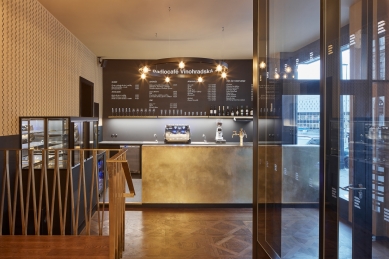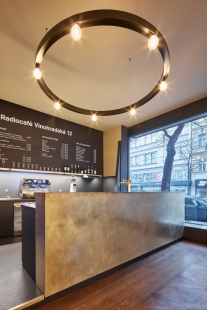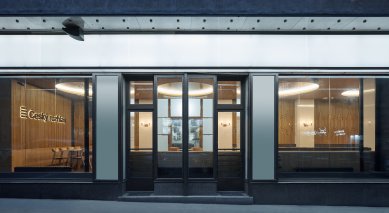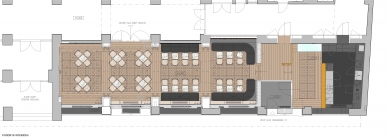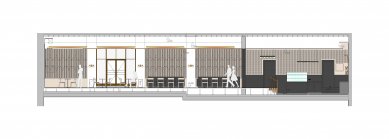
Radiocafé Vinohradská 12

HISTORICAL CONTEXT
The building of Czech Radio on Vinohradská Street was constructed between 1929 and 1932 in the functionalist style according to the design of Bohumil Sláma. The main investor of the construction was the Ministry of Posts and Telegraphs, as new facilities were to house not only Radiojournal (the then name of Czech Radio) but also the Directorate of Posts and Telegraphs in Prague (presidency, auxiliary offices, and individual departments on the top four floors) and the postal and telegraph office Prague 34 (on the ground floor facing Balbínova Street). On the ground floor towards Maršál Foche Street and at the corner, it was also planned to accommodate several shops. Individual separate groups were structurally completely separated in the project, but with the possibility of purposeful connection between them (Radiojournal – Directorate of Posts and Telegraphs – Post Office) with the intention of further expanding the radio rooms without restricting broadcasting operations.
During World War II, the building was hit by an aerial bomb. In its history, the building has been reconstructed and extended several times – some structural modifications were successful, others less so. A major reconstruction of the original building at Vinohradská 12 took place in two time intervals: from 2004 to 2005 and from 2007 to 2011.
The building is listed as a cultural monument.
ASSIGNMENT
Czech Radio wanted to open up more to the public, and therefore needed a space for mutual interaction. A place where people and the radio sphere can get to know each other, come together, and inspire one another. An informal café for live broadcasts, a pleasant and elegant environment for social events.
The task was to connect two original commercial units into one café space. We were aware that we were entering a building of high historical and architectural value. At the same time, we faced the client's requirements: to incorporate modern elements and technologies into the space to enable live broadcasting directly from the café, and to operationally and visually link the café with the entrance hall of Czech Radio, so that occasional social events could also be held there.
DESIGN
We wanted a café that corresponds to the aesthetics of the building: clean, simple, and elegant. With a reminiscence of the 1930s, but also using modern construction techniques and materials. Such a solution, of course, places adequate demands on service and café staff, if we want to return in time to the era of the First Republic on the city street in the center of Prague.
The entrance from the street leads into a space with a bar and is aligned in height with the street, unlike the main café space. This space is separated from the bar by several steps for the sake of spatial clarity and usability and is connected to the entrance hall of the historic building.
For surfaces and materials, we use a warm color palette in combination with white glass, which refers to the marble cladding in the entrance hall. Oak flooring, a brass bar with a railing, leather benches, and marble tables represent materials that have been used for centuries. We duplicate the rhythm of the columns from the entrance side of the hall into the café space to better arrange the area and create small pauses between groups of tables. The division of the space is accentuated by golden circles in the acoustic ceiling. A large glass partition with double doors to the entrance hall is a historical replica based on the existing doors in the hall, while also meeting the acoustic and fire safety requirements of the project. The double glass wall is a purely functional element that dampens noise from the street. Thanks to this doubling, it was unnecessary to intervene in the monumentally protected façade.
Given the nature of the café's operation with radio broadcasts, maximum requirements for acoustic properties, airborne sound insulation, attenuation, and absorption are placed on all constructions (besides aesthetic and functional requirements). Therefore, materials and constructions with the best values commonly achievable on the market are selected. Not only spatial but also constructional acoustics were addressed. In addition to visible parts, such as acoustic wall and ceiling panels, all technologies were evaluated with equal rigor, primarily airflow in outlets and media circulation.
Among several options for how extensively radio technology could be integrated into the café, the one ultimately chosen retained only the connection points in the space. This created columns gained further use, allowing the café to maintain seating capacity and spatial variability.
The building of Czech Radio on Vinohradská Street was constructed between 1929 and 1932 in the functionalist style according to the design of Bohumil Sláma. The main investor of the construction was the Ministry of Posts and Telegraphs, as new facilities were to house not only Radiojournal (the then name of Czech Radio) but also the Directorate of Posts and Telegraphs in Prague (presidency, auxiliary offices, and individual departments on the top four floors) and the postal and telegraph office Prague 34 (on the ground floor facing Balbínova Street). On the ground floor towards Maršál Foche Street and at the corner, it was also planned to accommodate several shops. Individual separate groups were structurally completely separated in the project, but with the possibility of purposeful connection between them (Radiojournal – Directorate of Posts and Telegraphs – Post Office) with the intention of further expanding the radio rooms without restricting broadcasting operations.
During World War II, the building was hit by an aerial bomb. In its history, the building has been reconstructed and extended several times – some structural modifications were successful, others less so. A major reconstruction of the original building at Vinohradská 12 took place in two time intervals: from 2004 to 2005 and from 2007 to 2011.
The building is listed as a cultural monument.
ASSIGNMENT
Czech Radio wanted to open up more to the public, and therefore needed a space for mutual interaction. A place where people and the radio sphere can get to know each other, come together, and inspire one another. An informal café for live broadcasts, a pleasant and elegant environment for social events.
The task was to connect two original commercial units into one café space. We were aware that we were entering a building of high historical and architectural value. At the same time, we faced the client's requirements: to incorporate modern elements and technologies into the space to enable live broadcasting directly from the café, and to operationally and visually link the café with the entrance hall of Czech Radio, so that occasional social events could also be held there.
DESIGN
We wanted a café that corresponds to the aesthetics of the building: clean, simple, and elegant. With a reminiscence of the 1930s, but also using modern construction techniques and materials. Such a solution, of course, places adequate demands on service and café staff, if we want to return in time to the era of the First Republic on the city street in the center of Prague.
The entrance from the street leads into a space with a bar and is aligned in height with the street, unlike the main café space. This space is separated from the bar by several steps for the sake of spatial clarity and usability and is connected to the entrance hall of the historic building.
For surfaces and materials, we use a warm color palette in combination with white glass, which refers to the marble cladding in the entrance hall. Oak flooring, a brass bar with a railing, leather benches, and marble tables represent materials that have been used for centuries. We duplicate the rhythm of the columns from the entrance side of the hall into the café space to better arrange the area and create small pauses between groups of tables. The division of the space is accentuated by golden circles in the acoustic ceiling. A large glass partition with double doors to the entrance hall is a historical replica based on the existing doors in the hall, while also meeting the acoustic and fire safety requirements of the project. The double glass wall is a purely functional element that dampens noise from the street. Thanks to this doubling, it was unnecessary to intervene in the monumentally protected façade.
Given the nature of the café's operation with radio broadcasts, maximum requirements for acoustic properties, airborne sound insulation, attenuation, and absorption are placed on all constructions (besides aesthetic and functional requirements). Therefore, materials and constructions with the best values commonly achievable on the market are selected. Not only spatial but also constructional acoustics were addressed. In addition to visible parts, such as acoustic wall and ceiling panels, all technologies were evaluated with equal rigor, primarily airflow in outlets and media circulation.
Among several options for how extensively radio technology could be integrated into the café, the one ultimately chosen retained only the connection points in the space. This created columns gained further use, allowing the café to maintain seating capacity and spatial variability.
The English translation is powered by AI tool. Switch to Czech to view the original text source.
0 comments
add comment


